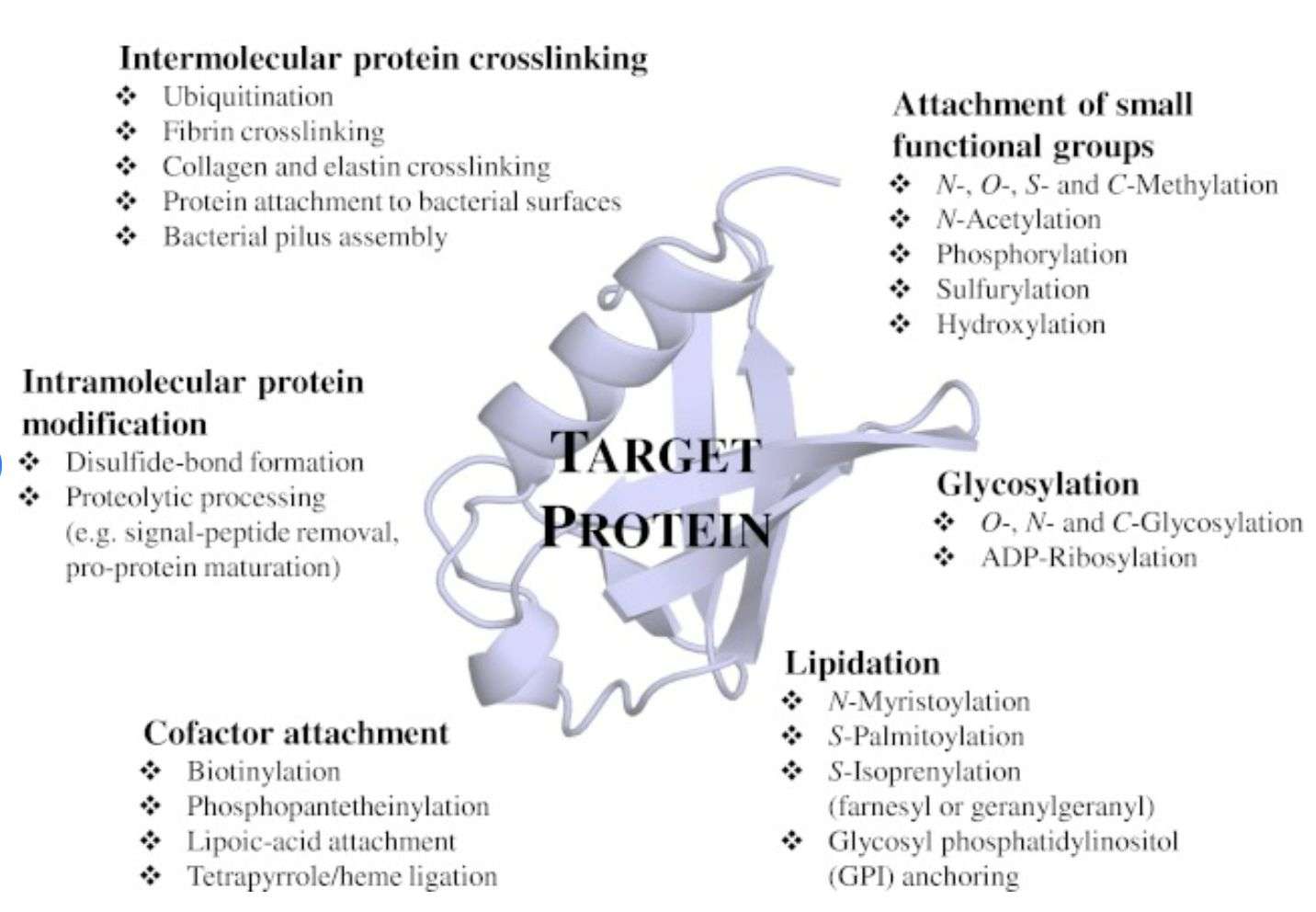Enzyme covalent chemical modification is a unique scientific process that involves altering enzyme molecules by covalently modifying their chemical properties. The significance of this process is enormous, as it opens up huge potential for enhancing or inhibiting enzyme activity, modulating enzyme function, or even creating entirely new enzyme functions. By understanding these modifications, we can gain valuable insights into enzyme behavior and interactions. These insights have broad applications in various scientific and industrial fields, including biotechnology, pharmaceutical and food industries.
 Schematic illustration of enzyme-catalyzed covalent modifications of proteins in vivo (Tobias Heck, et al., 2012)
Schematic illustration of enzyme-catalyzed covalent modifications of proteins in vivo (Tobias Heck, et al., 2012)
Technical Route
Our approach to Enzyme Covalent Chemical Modifications showcases methodical planning, systematic execution, and meticulous attention to detail. Here's a detailed overview of the comprehensive process:
| Step Name |
Objective |
Description |
| Enzyme selection |
To meticulously choose the most suitable enzyme based on the specific needs and unique requirements of the project. |
This initial step forms the bedrock of the modification process, setting the stage for subsequent steps. The chosen enzyme is crucial in determining the success of the modification process. |
| Covalent modification |
To modify the enzyme's chemical properties through a scientific process known as covalent modification. |
This phase requires substantial precision and expertise to transform the enzyme in a way that enhances its capabilities. It's not just about changing the enzyme but ensuring that the modifications lead to improvements in performance and functionality. |
| Activity measurement |
To measure the enzyme's activity post modification, providing insights into its behavior and performance. |
This critical step helps in understanding the implications of the modification on the enzyme's functionality. It involves scrutinizing the modified enzyme to assess whether it performs as expected, enabling necessary adjustments to be made if required. |
| Function analysis |
To conduct a thorough analysis of the modified enzyme's function and explore its potential applications in various scenarios. |
This final phase involves delving deep into the enzyme's potential applications and advantages. By comprehensively analyzing its function, we gain insights into how it can be utilized in different contexts, helping both us and the client understand the full spectrum of potential applications. |
Service Process
Our Enzyme Covalent Chemical Modifications Service Process is meticulously designed to ensure maximum client satisfaction and is delineated through the following steps:
- Initial Consultation: This is the first step where we have an opportunity to understand your unique needs and expectations.
- Detailed Project Discussion: After the initial consultation, we engage in a thorough project discussion. In this step, we outline our proposed approach to your project. Simultaneously, we encourage you to share your inputs, ideas, and feedback to ensure that our plan aligns with your vision.
- Project Initiation: Once we have a clear and shared understanding of the project's goals, we initiate the project. This step involves the mobilization of resources and setting up of necessary systems and processes.
- Regular Updates: We believe in maintaining transparency and open lines of communication with our clients. Therefore, once the project is underway, we keep you informed at every stage about the progress we are making.
- Interim Report: During the execution of the project, we provide an interim report. This report gives you an update on our progress, highlighting the tasks that have been completed and outlining the tasks that are still to be done.
- Final Comprehensive Report: At the end of the project, we present a comprehensive final report. This report details all the work we've done, the methodologies we have employed, the challenges we faced, and the solutions we adopted. Most importantly, it presents the results we've achieved.
- Post-Project Review: After the completion of the project, we engage in a post-project review. This is an opportunity for us to discuss the project outcomes, take your feedback, and understand areas of improvement for future projects.
We're here to assist you. If you have any questions, need more information, or would like to discuss a potential project, please don't hesitate to contact us. Our team is always eager to help and share our expertise.
Applications
| Application |
Description |
| Biocatalysis |
Enzyme covalent chemical modifications are extensively utilized in biocatalysis to enhance enzyme stability, substrate specificity, and catalytic efficiency for various industrial processes including the production of pharmaceuticals, fine chemicals, biofuels, and food additives. These modifications often involve site-specific conjugation or immobilization techniques. |
| Drug Development |
Enzyme covalent chemical modifications play a pivotal role in drug development, particularly in enhancing the pharmacokinetic properties of therapeutic enzymes. Modifications such as pegylation, glycosylation, or lipidation are employed to improve enzyme stability, extend half-life, reduce immunogenicity, and enhance tissue targeting, thereby improving the efficacy and safety of enzyme-based therapies. |
| Biosensors |
Enzyme modifications are widely employed in biosensors to enhance the sensitivity, selectivity, and stability of enzymes, enabling precise detection of target analytes in various samples. These modifications can include covalent attachment to transducer surfaces, encapsulation within matrices, or incorporation into nanomaterial-based platforms, facilitating the development of highly sensitive and specific biosensing devices for applications in healthcare, environmental monitoring, and food safety. |
| Biomedical Research |
In biomedical research, enzyme covalent modifications are utilized to investigate enzyme function, structure-activity relationships, and cellular signaling pathways. Chemical modifications such as phosphorylation, acetylation, or ubiquitination mimic post-translational modifications, allowing researchers to elucidate the roles of enzymes in physiological processes, disease mechanisms, and drug responses. Enzyme labeling techniques, such as fluorescent or radioactive tagging, facilitate the visualization and tracking of enzyme localization and dynamics within biological systems. |
| Bioconjugation |
Enzyme modifications are integral to bioconjugation strategies aimed at attaching enzymes to nanoparticles, polymers, or other molecules for various applications. These bioconjugates enable targeted delivery, controlled release, and enhanced stability of enzymes in therapeutic, diagnostic, and biotechnological contexts. Covalent coupling techniques, such as amine or thiol chemistry, facilitate the conjugation of enzymes to functionalized carriers, enabling tailored designs for applications such as targeted drug delivery, imaging probes, and biocatalytic reactors. |
| Protein Engineering |
Enzyme covalent chemical modifications play a crucial role in protein engineering to modulate enzyme properties and functions. Techniques such as directed evolution and rational design are combined with chemical modifications to improve enzyme stability, alter substrate specificity, and enhance catalytic activity for desired applications. Site-specific mutagenesis followed by chemical conjugation or crosslinking allows precise control over enzyme structure and function, enabling the development of tailor-made enzymes with enhanced performance and novel functionalities. |
| Nanobiotechnology |
Enzyme covalent modifications play a key role in nanobiotechnology by facilitating the integration of enzymes with nanomaterials for diverse applications. Nanoparticle-enzyme hybrids are engineered through covalent conjugation or surface functionalization, enabling synergistic interactions between enzymes and nanomaterials for enhanced catalytic performance, biocompatibility, and targeting specificity. These nano-bioconjugates find applications in areas such as biosensing, therapeutics, imaging, and environmental monitoring, offering novel solutions for biomedical and biotechnological challenges. |
FAQs
Below are some frequently asked questions (FAQs) about Enzyme Covalent Chemical Modifications. They cover various aspects of this process, including its definition, importance, potential effects on enzyme activity, application fields, and how you can collaborate with us. If you have more specific or detailed questions, don't hesitate to get in touch with us directly.
Q: Can you define Enzyme Covalent Chemical Modifications in simple terms?
A: Enzyme Covalent Chemical Modifications is a complex yet crucial process in which the chemical properties of enzyme molecules are modified in a covalent manner. This modification can greatly influence their activity and function, making it an interesting area of study.
Q: What makes the study of Enzyme Covalent Chemical Modifications so crucial?
A: The study of Enzyme Covalent Chemical Modifications is not just vital but also fascinating as it offers significant insights into the behavior and interactions of enzymes. Such knowledge has wide-ranging applications in various scientific and industrial domains, making it an indispensable part of our understanding of enzyme function and behavior.
Q: Can the process of Enzyme Covalent Chemical Modifications enhance the activity of enzymes?
A: Absolutely, yes. Enzyme Covalent Chemical Modifications can have a profound effect on enzyme activity. This process can either enhance or inhibit the activity of enzymes, making it a powerful tool in regulating enzyme function.
Q: Is it possible for Enzyme Covalent Chemical Modifications to regulate the function of enzymes?
A: Indeed, it is. The process of Enzyme Covalent Chemical Modifications holds immense potential in effectively regulating enzyme function. This makes it a key aspect of enzyme research and application.
Q: Can Enzyme Covalent Chemical Modifications lead to the creation of new functions in enzymes?
A: Yes, it certainly can. Enzyme Covalent Chemical Modifications can lead to the creation of completely new functions in enzymes, adding another layer of complexity and potential to enzyme research and application.
Q: In which fields can the principles of Enzyme Covalent Chemical Modifications be applied?
A: There is a broad range of application areas for Enzyme Covalent Chemical Modifications. They are used in numerous scientific and industrial fields, including but not limited to biotechnology, pharmaceuticals, and the food industry.
Q: Could you elaborate on the service process involved in Enzyme Covalent Chemical Modifications?
A: The service process involved in Enzyme Covalent Chemical Modifications is comprehensive and client-focused. It includes an initial consultation, detailed project discussion, project initiation, interim progress reports, and a final report presenting the results and findings.
Q: What is the technical route of Enzyme Covalent Chemical Modifications?
A: The technical route of Enzyme Covalent Chemical Modifications involves four major steps: careful selection of enzymes, covalent modification of the selected enzymes, measurement of enzyme activity post-modification, and a thorough analysis of the function of the modified enzymes.
Q: How can I establish a collaboration with you?
A: We are always open to new collaborations and eager to hear from interested parties. You can get in touch with us through the contact information provided on our website. We look forward to exploring potential collaborations with you.

































 Schematic illustration of enzyme-catalyzed covalent modifications of proteins in vivo (Tobias Heck, et al., 2012)
Schematic illustration of enzyme-catalyzed covalent modifications of proteins in vivo (Tobias Heck, et al., 2012)